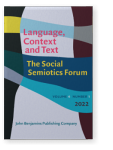Vol. 4:1 (2022) ► pp.26–60
The embodiment of language
Psychiatry, psychotherapy and linguistics
In this paper an understanding of psychotherapeutic conversation is outlined emphasising whole-body functioning. The underpinning of conversation by both Central and Autonomic Nervous Systems (CNS & ANS) and evolutionary developments that support social engagement and language are considered. An idea will be taken up that for psychotherapy, language needs to be understood within each patient as more than meets the eye, rather than less, providing a potential for exchanges in the therapeutic conversation that enhance the growth of self for each individual. The notion of culminative patterns of communicative interaction speaks to this growth and the enhancement of a sense of meaning in personal contexts. This goes beyond an analytic approach, implying synthesis, integration and growing coherence over time. Human development is towards social engagement, building upon a capacity for relations that are rewarding to the parties involved (Meares 2016). The problem of responding to embodied communication in psychotherapy is considered in relation to moments of meeting, seen as mutative in therapy. Each person is an embodied text with potential for elaboration, re-shaping and discovery. Clinical illustrations are provided, demonstrating a linguistic model of therapeutic growth and an experimental method that provides a window onto the exchange characteristics of language. To close, the problem of systematising embodiment and its relation to the conversation is considered, along with the implications for therapy and future research, integrating linguistics and interactive functional measures of the body.
Article outline
- 1.Introduction
- 2.Embodied language
- 3.Polyvagal theory
- 4.Local determination of meaning
- 5.Local development of text in psychotherapy
- 6.Responding to embodiment
- 7.The culminative embodied text: Self in therapy
- 8.A window onto language in action and the generation of meaning
- 9.Systematising embodiment and its relation to the conversation
- Acknowledgements
- Notes
-
References
